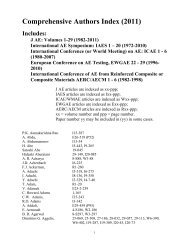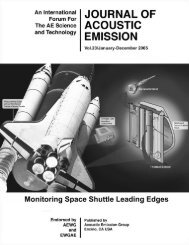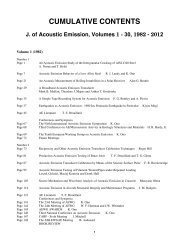Journal of AE, Volume 25, 2007 (ca. 26 MB) - AEWG
Journal of AE, Volume 25, 2007 (ca. 26 MB) - AEWG
Journal of AE, Volume 25, 2007 (ca. 26 MB) - AEWG
You also want an ePaper? Increase the reach of your titles
YUMPU automatically turns print PDFs into web optimized ePapers that Google loves.
STRUCTURAL INTEGRITY EVALUATION USING<br />
ACOUSTIC EMISSION<br />
KANJI ONO<br />
Department <strong>of</strong> Materials Science and Engineering<br />
University <strong>of</strong> California, Los Angeles, California 90095-1595<br />
Abstract<br />
This paper reviews various approaches used in acoustic emission (<strong>AE</strong>) testing <strong>of</strong> structures<br />
so that further improvements <strong>ca</strong>n be realized in this important appli<strong>ca</strong>tion <strong>of</strong> <strong>AE</strong> technology.<br />
Since the late 1950s, many successful <strong>AE</strong> tests <strong>of</strong> structures have been completed. Yet, the<br />
spread <strong>of</strong> <strong>AE</strong> technology is underwhelming. To achieve a wider use <strong>of</strong> <strong>AE</strong>, we attempt to organize<br />
and reexamine the <strong>AE</strong> methodology applied to structural integrity monitoring in four steps.<br />
1. <strong>AE</strong> Sources: Primary sources <strong>of</strong> brittle fracture, micro- or macro-cracks in contrast to secondary<br />
sources <strong>of</strong> friction or fretting, rust, etc. 2. Evaluation Tools: Kaiser effects, arising from the<br />
irreversibility <strong>of</strong> <strong>AE</strong>, allow the detection <strong>of</strong> prior loading level and <strong>of</strong> damage states. Related indices<br />
are also useful. 3. Source Lo<strong>ca</strong>tion: This approach identifies the area <strong>of</strong> integrity loss. 4.<br />
Source Characterization: Combined <strong>AE</strong> parameters give good insight to the flaw types, but many<br />
other methods, including signal amplitude, signal frequency, waveform and wave propagation<br />
analysis and moment tensor analysis, <strong>ca</strong>n be useful. Avenues for better <strong>AE</strong> technology utilization<br />
are suggested. These include: to accumulate basic data on structures with standardized procedures,<br />
to devise combinatorial approach between lo<strong>ca</strong>lized damage evaluation and long-range<br />
detection and to develop regional or global database under international cooperation. The final<br />
goal <strong>of</strong> determining the structural integrity is attainable only with systematic approach with damage<br />
quantifi<strong>ca</strong>tion via NDT and with the use <strong>of</strong> fracture mechanics.<br />
Keywords: Structural Integrity; <strong>AE</strong> Methodology, <strong>AE</strong> Sources, Source Characterization<br />
1. Introduction<br />
Acoustic emission (<strong>AE</strong>) testing <strong>of</strong> structures began in California in the midst <strong>of</strong> the space<br />
race [1]. From the early years, R&D activity was high; 400+ papers on this topic were compiled<br />
for 1970-72 period [2]. By now the methodology has well-established commercial basis in most<br />
industrialized countries. Yet, we are far from the goal <strong>of</strong> providing quantitative answers regarding<br />
the integrity and remaining lifetime <strong>of</strong> structures. Current status <strong>of</strong> <strong>AE</strong> testing <strong>of</strong> structures is<br />
reviewed here to advance this important appli<strong>ca</strong>tion <strong>of</strong> <strong>AE</strong> technology.<br />
The basic <strong>AE</strong> testing strategy is to detect <strong>AE</strong> signals globally from the entire structure under<br />
test using above-normal loading (or pressure), to identify their lo<strong>ca</strong>tions, to group them (clustering)<br />
and to rank the groups comparing the collective <strong>AE</strong> characteristics with empiri<strong>ca</strong>l database<br />
[3-5]. The key issue is the presence or absence <strong>of</strong> criti<strong>ca</strong>l intense sources in the structure. During<br />
the past 40+ years, many <strong>AE</strong> tests <strong>of</strong> structures have successfully utilized this strategy. Most <strong>of</strong>ten,<br />
<strong>AE</strong> has been used as an alternative to internal inspection <strong>of</strong> tanks and pressure vessels. However,<br />
details remained inaccessible in proprietary reports and meaningful assessment has been<br />
unavailable. Some recent articles give valuable insight to industrial <strong>AE</strong> practices [6-8]. The<br />
strategy <strong>of</strong> <strong>AE</strong> testing relies on the presumed principle that active defects produce <strong>AE</strong> in asymptoti<strong>ca</strong>lly<br />
increasing number with rising load. We also assume larger defects give stronger <strong>AE</strong>.<br />
J. Acoustic Emission, <strong>25</strong> (<strong>2007</strong>) 1 © <strong>2007</strong> Acoustic Emission Group








